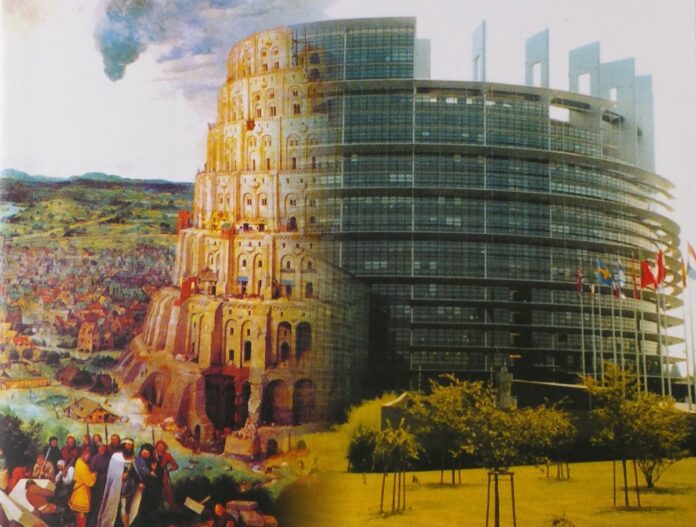A new Reich in the Red Dawn of the Digital Era (first part) (English version at the end of this article)
Dacă unii dintre noi își imaginează că prima măsură luată de elita globală pentru impunerea unei Noi Ordini Mondiale ar fi de natură militară, venită din Statele Unite, sau de natură economică, dintr-o criză financiară, atunci este amarnic indus în eroare. Va fi mai degrabă o preluare a puterii religioase cu originea la Vatican, în Roma, spune Serge Monast în „Protocoalele de la Toronto”. Legată de ascensiunea la putere a anti-Papei. Acest lucru va anunța declinul întregului creștinism, un declin care începe totuși din America odată cu preluarea puterii internaționale de către organizația Națiunilor Unite și caracatița sa uriașă de interconexiuni (vezi Serge Monast, Protocoalele de la Toronto, 1995, pp. 15, 24-25).
La fel și-n Europa. Deoarece, așa cum rezultă din protocoale, acest proces de distrugere începe cu căderea națiunilor-state și distrugerea moștenirii iudeo-creștine, deci a culturii și civilizației occidentale a vechiului Imperiu Roman. Pentru construirea unuia nou după modelul Babel.
Măsura ar fi legată și de un proiect care a existat într-o formă ascunsă de secole, privind reconstrucția vechiului Templu Solomon. Și care este atât de vechi precum descoperirea Lumii Noi de către ultimul templier, Cristofor Columb (vezi Ruggero Marino, Cristofor Columb – ultimul templier. De asemenea Frances Amelia Yates, Iluminismul rozicrucian).
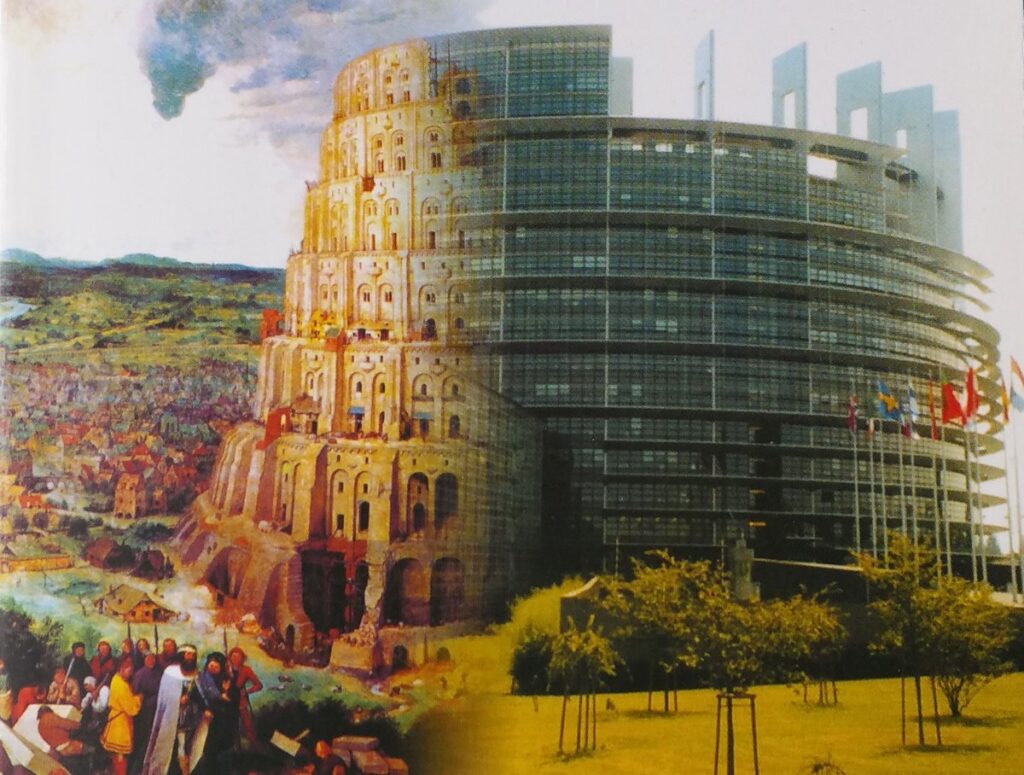
Noul Imperiu Roman modelat după spiritul Babilonului
După cel de-al Doilea Război Mondial, actorii politici – în special Franța și Germania – alături de mișcarea paneuropeană care începuse la Viena au făcut primii pași spre construirea a ceea ce este astăzi cunoscută ca Uniunea Europeană.
Comunitatea Europeană a Cărbunelui și Oțelului (CECO) a fost unul dintre ei. Înființată la propunerea ministrului francez Robert Schuman, CECO a fost încă de la început o organizație internațională fondată pe principiul supranaționalismului. Întocmai ca și mișcarea paneuropeană a fost creată pentru a unifica Europa prin punerea în comun a resurselor industriale vitale, având astfel mijloacele de producție și materiile prime necesare mașinilor de război. Pentru a preveni alte conflicte care ar fi trebuit să vină dinspre Est. Între Franța și Germania care încheiase un pact cu Rusia, Pactul Molotov-Ribbentrop din 23 august 1939 (vezi Wikipedia, The European Coal and Steel Community).
Șase țări au răspuns apelului din 9 mai 1950 al Declarației Schuman și au semnat un an mai târziu, la 18 aprilie 1951, Tratatul de la Paris: Belgia, Franța, Italia, Luxemburg, Olanda și Germania de Vest. Acestea vor forma nucleul dur al Comunităților Europene (CE) numite „cele șase interioare” sau simplu „cele șase” state membre fondatoare care vor implica celelalte țări în proiectul de integrare europeană. Mult mai bine spus pentru (re)-construcția Europei după al Doilea Război Mondial, a unei Noi Europe (fr. la construction européenne).
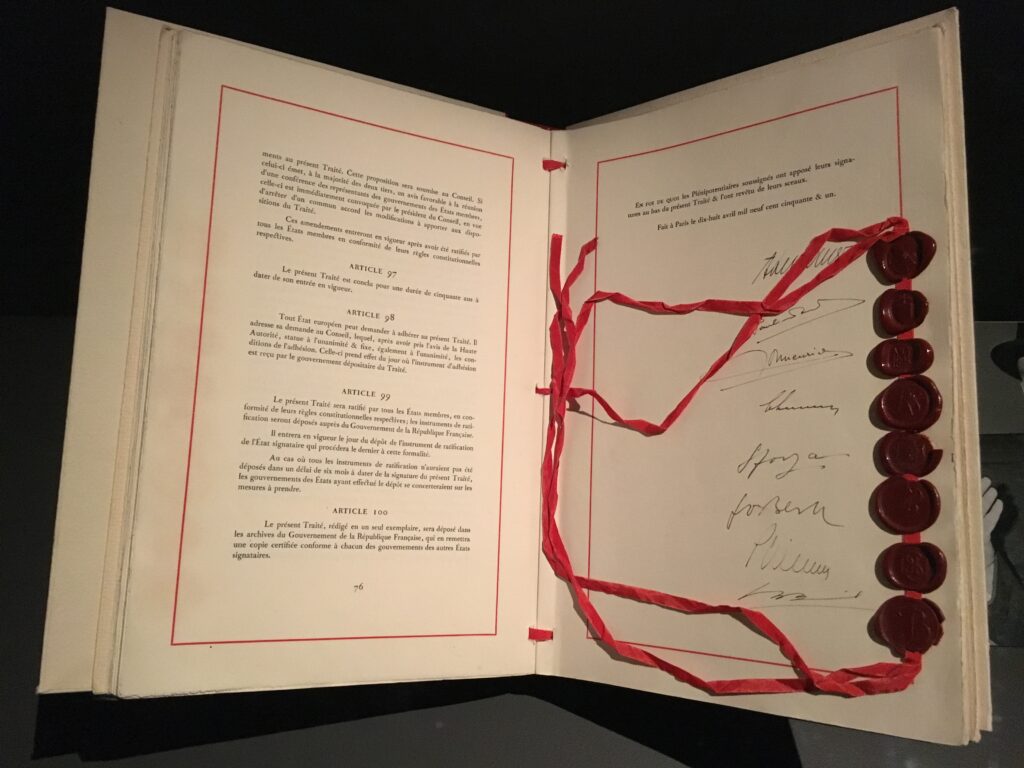
Ce a urmat după a fost încercarea celor șase de a crea o Comunitate Europeană de Apărare la propunerea noului prim-ministru francez René Pleven, care ar fi permis Germaniei de Vest să se rearmeze sub autoritatea unui comandament militar european comun. În acest sens a fost semnat un alt tratat în 1952. Spre surprinderea tuturor, Senatul Franței a respins atunci Planul Pleven pentru crearea unei Comunități Europene de Apărare (CEA) cu o forță de apărare paneuropeană (vezi Wikipedia, The Inner Six. De asemenea, Treaty establishing the European Defence Community).
După cum vedem, CECO a fost creată de la început pentru a uni și a apăra Europa de viitoarele conflicte. Dar scopul său nu a fost să rămână un simplu furnizor de arme pe o piață liberă. De asemenea să se extindă în noi entități mult mai mari formate după ea, cum ar fi Comunitatea Economică Europeană (CEE sau „Piața comună”) și Comunitatea Europeană a Energiei Atomice (CEEA sau Euratom). Denumiri care, totuși, vor fi lăsate în urmă și schimbate cu numele de Comunități Europene (CE), și în cea mult mai târzie de Uniune. În timpul Summit-ului de la Paris din ’72, s-a spus că cele șase state membre inițiale ar trebui să dea o nouă dimensiune Comunității și să realizeze Uniunea Economică și Monetară.
„Termenul CEE a fost foarte repede înlocuit cu – Comunitatea Europeană (CE). Prin eliminarea cuvântului „economic” din titlu, CEE (CE) preia autoritatea asupra tuturor domeniilor vieții. La rândul său, termenul „comunitate” a fost apoi înlocuit pentru a deveni – Uniunea Europeană (UE).
Așadar, ceea ce a început la sfârșitul anilor 1940 ca o alianță a șase țări (națiuni/state) legate de industria cărbunelui și a oțelului a progresat pentru a deveni ceva cu mult dincolo de începuturile ei” (Christians Together, 2007. A se vedea, de asemenea, Bulletin of the European Communities, octombrie 1972).
Chiar dacă sunt puncte de vedere diferite cu privire la formarea, extinderea și rolul UE, rămân foarte puțini cei care nu vor fi de acord cu utilizarea termenului de „super-stat” pentru o Uniune care nu a devenit încă o Federație de State.
Atât Robert Schuman, cât și René Pleven, au fost tributari ideii unei comunități și armate supranaționale pe care au preluat-o de la Jean Monnet. Întrebarea este cât de aproape sau de departe este Europa de ideile și textele care au stat la temelia ei, cu care a plecat la drum? Pentru jurnalistul român Deutsche Welle Horațiu Pepine, Europa pare să se abată de la drumul ei, abandonând textele fondatoare și lansându-se fără instrumente de navigație pe o traiectorie complet necunoscută (DW-România). În ceea ce mă privește, nu cred că este prea departe de a realiza acea Comunitate și Armată supranațională pe care au vrut să o construiască de la început.
Pentru mulți creștini, spiritul Babilonului se manifestă în Europa. De fapt, dacă ne uităm la clădirea Louise Weiss a Parlamentului European din Strasbourg, observăm cu ușurință asemănarea strânsă cu pictura „Turnul Babel” a lui Pieter Brueghel cel Bătrân. „Acest lucru se poate datora faptului că turnul lui Bruegel a fost, la rândul său, inspirat de Colosseum” (The Irish Times, 2016). Un afiș din ’92 care a circulat pe scară largă și a fost rapid retras din cauza simbolismului său ilustrează foarte bine această asemănare la fel ca motto-ul „Europa: multe limbi, o singură voce”. Motto-ul elitei globale. Pentru o nouă Comunitate a unui Imperiu Roman reînviat?
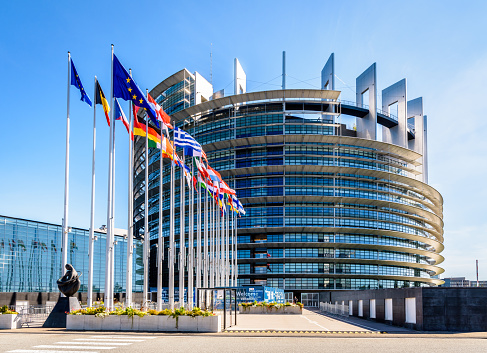
UE abundă în simbolism, ocultism, și mistere de orice fel. Acesta a fost motivul pentru care mulți creștini au protestat atunci împotriva afișului, mai ales din cauza stelelor inversate de pe el – cunoscute și sub numele de pentagrame inversate, un simbol ocult pentru Satana – principala obiecție care a dus la retragere. Un alt lucru bizar, care ne face să ne gândim la Apocalipsa lui Ioan, este sculptura modernă a unei femei călare pe o fiară, plasată chiar în fața clădirii biroului UE. Faptul că scaunul 666 din Parlament rămâne aproape tot timpul gol (Alan Lamont. Vezi și The Irish Times, 1999).
Și-a pierdut Europa busola? Maestrul Shakespeare ar fi răspuns: „Ceva e putred!” Dar nu în Danemarca. Ceva este în neregulă cu lumea în care trăim. Lumea noastră, nu doar Europa, a devenit mai mult un loc pentru manifestarea spiritului rătăcitor al Babilonului.
O armată internațională pentru un nou Reich
„Nu vrem un alt comitet, avem deja prea multe. Ceea ce ne dorim este un om de statură suficientă pentru a păstra loialitatea tuturor oamenilor și pentru a ne scoate din mocirla economică în care ne scufundăm. Trimite-ne un astfel de om și fie el Dumnezeu sau Diavol, îl vom primi”. Sună profetic, dar acestea au fost cuvintele lui Paul-Henri Spaak, fostul prim-ministru belgian și primul președinte al Comunității Europene a Cărbunelui și Oțelului (Christians Together, 2012).
Ideea de a crea o Uniune care va aduce pace și prosperitate între toate națiunile este mult mai veche decât Tratatul de la Paris, chiar de la înființarea Ligii Națiunilor Unite (fr. Société des Nations). Ideea a căpătat teren în rândul pacifiştilor din cercuri foarte diferite, între anii 1870 şi ’80, care au înfiinţat Uniunea Interparlamentară (vezi Archive.ipu.org.). Și nu aparținea doar Occidentului. După cum a menționat Edith K. Roosevelt, într-o rubrică din 1962, a fost și propunerea lui Lenin:
„Ca și alte organizații internaționale, conferințele UIP au devenit ceea ce jurnalistul iugoslav Mladen Iveković numește „un forum pentru dialoguri constructive est-vest” cu privire la problemele care împart lumea. Aceste „dialoguri est-vest” servesc la implementarea propunerii lui Lenin pentru „Statele Unite ale lumii”, publicată în nr. 40 al organului rus, Socialist-Democrat, din 1915. Rezoluțiile UIP includ:
Rezoluția prin care se solicită „limitări ale suveranității statului” (a 51-a Conferință UIP, Berna, 1952).
Înființarea unei „forțe internaționale permanente de poliție” sub egida ONU pentru „a asigura securitatea colectivă” (a 47-a Conferință UIP, Rio de Janeiro, 1958).
Rezoluția prin care se solicită adoptarea planului senatorului Mike Monroney pentru „înlăturarea obstacolelor din calea comerțului mondial”, cunoscută sub numele de Asociația Internațională de Dezvoltare – organizată recent în cadrul Băncii pentru Reconstrucție și Dezvoltare sau a Băncii Mondiale (a 48-a Conferință UIP, Varșovia, 1959)” (Edith K. Roosevelt, 1962).
Deci, ca și în cazul UE, ceea ce a început ca o simplă Conferință, cu ideea de a reuni membri ai Parlamentului din toate țările, a mers foarte departe. Astăzi Agenda UIP abordează probleme precum guvernarea democratică, drepturile omului, egalitatea de gen, securitatea internațională, pacea și dezvoltarea ca și cum ar fi Parlamentul Mondial pentru un Guvern (sau Uniune) Mondial(ă).
Nu trebuie să uităm că mișcarea paneuropeană, Tratatul de la Paris, CECO și ce a urmat după au apărut pe fundalul celor două războaie mondiale ca alternative la amenințările venite dinspre Est pentru construirea unei Comunități Europene de Apărare, parte a unui plan mult mai mare pentru un Guvern Mondial. Dar este socialismul (sau comunismul) albastru o alternativă la socialismul (sau comunismul) roșu? Din punctul meu de vedere, nu cred. Pentru că folosește aceleași arme, armele terorii și ale propagandei într-o formă mult mai ascunsă.

Pamfletul lui Rosika Schwimmer și Lola Maverick Lloyd, din cadrul Campaniei pentru un Guvern Mondial a anilor ’37 – care a pus bazele primei organizații federaliste mondiale din secolul XX, indică clar acest lucru. Misiunea Campaniei a fost „de a promova un guvern mondial federal care să reprezinte direct interesele oamenilor, spre deosebire de interesele statelor”. „Prima platformă a campaniei a fost conturată în 1937 în pamfletul lor „Haos, război sau o nouă ordine mondială?”, care a cerut crearea unei convenții constituționale mondiale. La această convenție, se spera, să fie format un cadru pentru o Federație a Națiunilor și să fie programate alegeri democratice. Schwimmer și Lloyd au inclus un plan preliminar pentru acest nou organism federal, incluzând calitatea de membru cu drepturi depline pentru toate țările, reprezentare directă și mai multe organe ale guvernului. Printre elementele planului s-au numărat un nou sistem internațional de date, desființarea tuturor corpurilor militare, transferul pașnic al oamenilor din regiunile cu populație densă și o economie globală de liber schimb și comandă combinată” (vezi Matthew Snyder, Campaign for World Government. Records of the Chicago Office, februarie 2011, p. v).
Acum, lumea a fost aruncată din nou în haos. Iar căutarea construirii unei Comunități Europene de Apărare poate apărea din nou ca o necesitate în cadrul conflictelor Rusia-Ucraina. De fapt, cel mai recent exercițiu militar de apărare mondial Defender Europe 20, desfășurat de NATO și aliații săi, un exercițiu mai complex decât istoricul REFORGER din perioada Războiului Rece, a avut loc în ultimii ani în diferite locații cu acest scop: pentru a preveni un conflict major pe continentul european cum ar fi războiul.
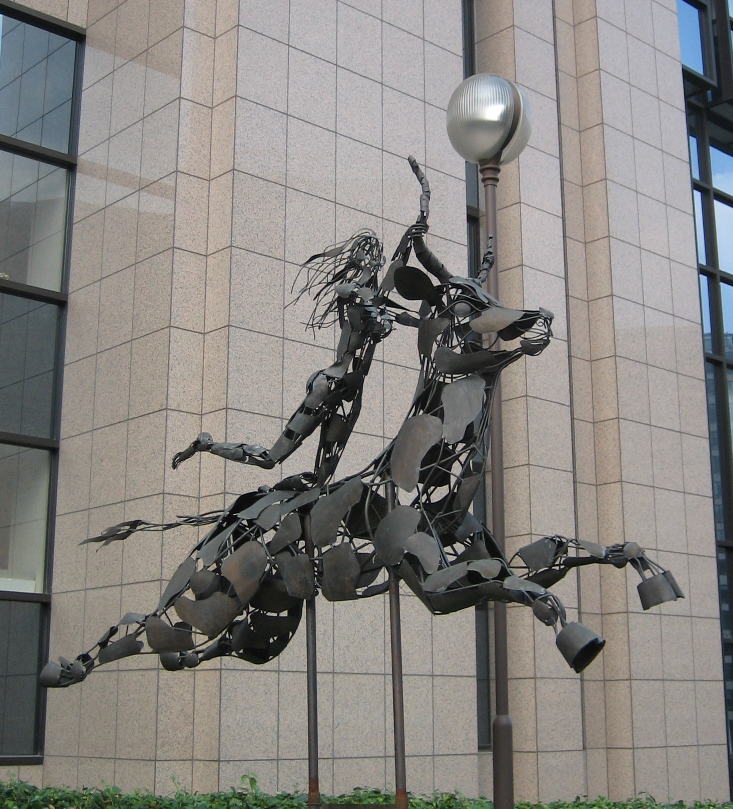
Vechiul exercițiu militar REFORGER de la sfârșitul anilor 1960 până la începutul anilor 1990 a însemnat întoarcerea forțelor în Germania (REturn of FORces to GERmany). „Conform Centrului pentru Studii Strategice și Internaționale (CSIS): La sfârșitul anilor 1980, Statele Unite au menținut aproximativ 340.000 de militari staționați permanent în Europa pentru a descuraja amenințarea convențională pe care Uniunea Sovietică și forțele Pactului de la Varșovia o reprezentau Germaniei de Vest și Europei Occidentale”. Astăzi, „forțele terestre SUA au fost în mare parte staționate în Polonia, cu elemente care efectuează de asemenea antrenamente și exerciții în țările baltice, Bulgaria, România și Germania. Această rotație asigură că există cel puțin trei echipe de luptă de brigadă în Europa în orice moment” (vezi IN FOCUS, 14 ianuarie 2020).
Întrebarea este dacă aceste forțe terestre vor servi drept pretext pentru elita globală pentru a înființa acea „forță internațională permanentă de poliție”, așa cum ne-a spus rezoluția celei de-a 47-a Conferință UIP de la Rio de Janeiro. Și dacă acest exercițiu militar multinațional va fi piatra de temelie pentru formarea unei Armate Internaționale a unui Nou Reich?
Într-o ședință specială prin telefon, organizată de U.S.-European Media Hub la Bruxelles, pe 4 martie 2020, Generalul-maior Andrew Rohling a declarat DEFENDER și exercițiile sale asociate „de natură defensivă”. Și că „nu sunt direcționate către nicio țară sau amenințare specifică”. Deși, prin Evaluarea Comună a Războiului, desfășurată în cadrul exercițiului de la postul de comandă de la Grafenwoehr, Germania, se așteaptă „să antreneze unitățile mai mari la nivel de corp și divizie în război așa cum o vedem în anul 2028”. Într-un conflict Rusia-Ucraina, acesta „va face parte din acel scenariu la exercițiul de la postul de comandă, dar nu așa cum ne antrenăm în imaginea de ansamblu a manevrei la sol aici în DEFENDER-Europe 20”, a spus Generalul-maior Andrew Rohling. Și a încheiat Briefing-ul cu:
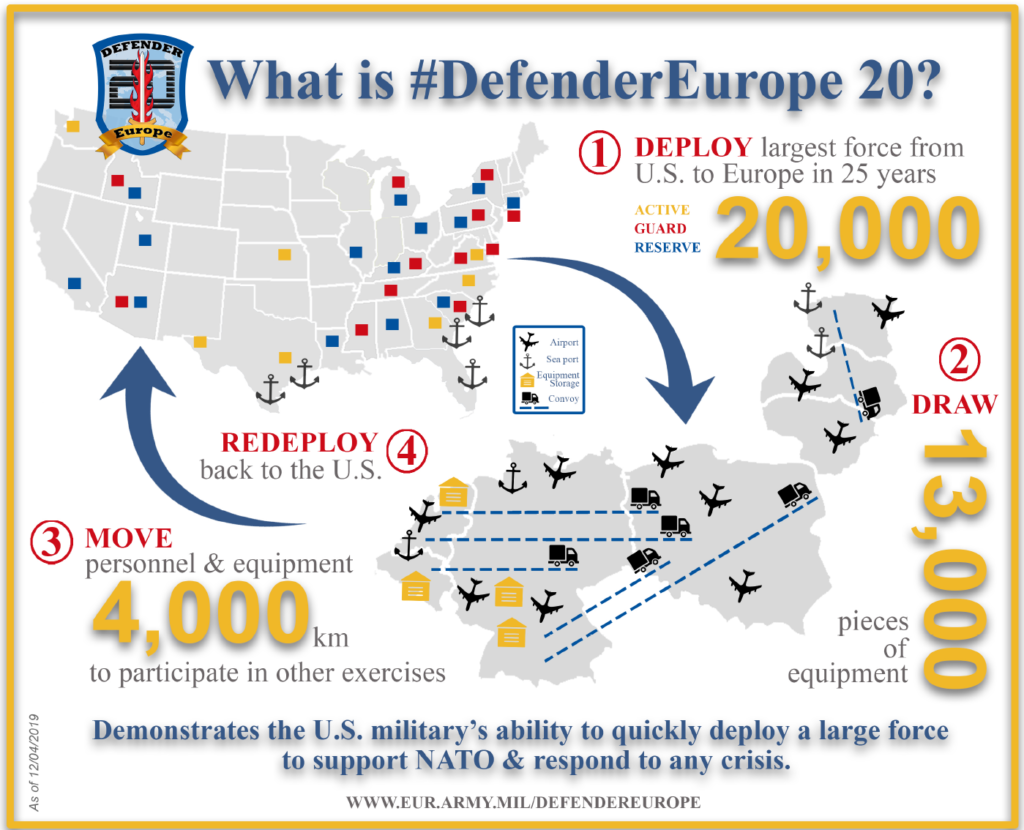
„Continuăm să credem că acesta este un exercițiu foarte important nu numai pentru Statele Unite, ci și pentru toți partenerii și aliații noștri europeni. Suntem foarte recunoscători fiecărei națiuni și pentru ceea ce a contribuit ea și așteptăm cu nerăbdare un mare eveniment, un mare eveniment de învățare care va ajuta la întărirea securității tuturor națiunilor noastre” (vezi The Brussels Media Hub, Special phone briefing on Defender 2020: transcript).
Această ultimă afirmație m-a uimit. La ce „mare eveniment” care „va ajuta la întărirea securității tuturor națiunilor noastre” se gândea Generalul-maior? Cel din 2028 pentru care DEFENDER se pregătește? Cu siguranță nu la războiul Rusia-Ucraina pe care îl avem deja în fața ochilor noștri.
Ana-Maria Caminski
Corespondent in Romania, pentru NASUL TV Canada
A new Reich in the Red Dawn of the Digital Era (first part)
If some of us imagine that the first measure taken by the global elite for imposing a New World Order would be of military nature, coming from the United States, or of economic nature, from a financial crisis, then it’s sorely misled. It will rather be a taken of religious power with origin at the Vatican, in Rome, says Serge Monast in the Toronto Protocols. Related to the rise of the anti-Pope to power. This will announce the decline of whole Christianity, a decline that however starts in America once with the International Power taken by the United Nations organization and its huge octopus of interlinks (see Serge Monast, Toronto protocols, 1995, pp. 15, 24-25).
In Europe too. Because, as it results from the Protocols, this process of destruction begins with the fall of Nation-states and the destruction of Judeo-Christian heritage, so of the Western culture and civilization of the old Roman Empire. For building up a new one after the Babel design.
The measure would be related also to a project that has existed in a hidden form for centuries, regarding the reconstruction of the old Solomon Temple. And which is so old like the discovery of the New World by the last Templar, Christopher Columbus (see Ruggero Marino, Cristoforo Colombo l’ultimo dei templari. Also Frances Amelia Yates, The Rosicrucian Enlightenment).
The New Roman Empire shaped after Babylon’s spirit
In the aftermath of the Second World War, political actors – especially France and Germany – alongside the Pan-European movement that started in Vienna have made the first steps toward building up what is known today as the European Union.
The European Coal and Steel Community (ECSC) was one of them. Founded at the proposal of French minister Robert Schuman, ECSC was from its very beginning an international organization based on the principle of supra-nationalism. As well as the Pan-European movement, was created to unite Europe by putting in common the vital industrial resources, thus having the means of production and the necessary raw materials for the machinery of war. To prevent further conflicts that were supposed to come from the East. Between France and Germany that had concluded a pact with Russia, the Molotov-Ribbentrop Pact of August 23, 1939 (see Wikipedia, The European Coal and Steel Community).
Six countries responded to the Schuman Declaration’s call of 9 May 1950 and signed a year later, on 18 April 1951, the Treaty of Paris: Belgium, France, Italy, Luxembourg, the Netherlands, and West Germany. Those will form the hard-core of the European Communities (EC) called the ‘Inner Six’ or simply ‘the Six’ founding member states who will engage the other countries in the European integration project. Much better said for the (re)-construction of Europe after WWII, of a New Europe (fr. la construction européenne).
What followed after was the attempt of the Six to create a European Defence Community at the proposal of new French Prime Minister René Pleven, which would have allowed West Germany to rearm under the authority of a common European military command. In this regard was signed another treaty in 1952. To everyone’s surprise, the Senate of France rejected then the Pleven Plan for creating a European Defence Community (EDC) with a pan-European defence force (see Wikipedia, The Inner Six. Also the Treaty establishing the European Defence Community).
As we see, ECSC was created from the beginning to unite and defend Europe from further conflicts. But its purpose was not to remain a simple guns provider on a free market. Also to expand into new much larger entities shaped after it, such as the European Economic Community (EEC or ‘Common Market’) and the European Atomic Energy Community (EAEC or Euratom). Designations that, however, will be left behind and changed by the name of European Communities (EC), and to the much later Union. During the ’72 Summit Paris, it has been spoken that the six original member states should give a new dimension to the Community and achieve the Economic and Monetary Union.
“The term EEC was very quickly replaced by – The European Community (EC). By dropping the word ‘economic’ from its title the EEC (EC) takes authority over all areas of life. In turn, the term ‘community’ was then replaced to become – The European Union (EU).
So what started in the late 1940s as an alliance of 6 countries (nation/states) relating to the coal and steel industries has progressed to become something far beyond its beginnings” (Christians Together, 2007. Also see Bulletin of the European Communities, October 1972).
Even if are different points of view regarding the formation, expansion, and role of the EU, there remain very few who will disagree with the use of the term ‘super-state’ for a Union that did not has become yet a Federation of States.
Both Robert Schuman and René Pleven were tributaries to the idea of a supranational Community and Army which took over from Jean Monnet. The question is how close or far is Europe from the ideas and texts that stood at its foundation, with which has left on the road? For the Deutsche Welle Romanian journalist Horațiu Pepine, Europe seems to deviate from her road, by abandoning its founding texts and launching itself without navigation instruments on a trajectory completely unknown (DW-Romania). As for me, I don’t think it’s too far from achieving that supranational Community and Army they wanted to build from the beginning.
To many Christians, the spirit of Babel manifests within Europe. As a matter of fact, if we look at the Louise Weiss Building of the European Parliament in Strasbourg, we easily notice the close resemblance with the ‘Tower of Babel’ painting of Pieter Brueghel the Elder. “This may be because Bruegel’s tower was in turn inspired by the Colosseum” (The Irish Times, 2016). A poster from ’92 that widely circulated and quickly was retired because of its symbolism illustrates very well this resemblance just like the motto ‘Europe: Many Tongues, One Voice’. Global elite’s motto. For a new Community of a revived Roman Empire?
EU abounds in symbolism, occultism, and mysteries of any kind. This was the reason why many Christians protested then against the poster, most of all because of the inverted stars from it – also known as reversed pentagrams, an occult symbol for Satan – the main objection leading to the withdrawal. Some other bizarre thing, that makes us think of the Apocalypse of John, is the modern sculpture of a Woman Riding to a Beast put right in front of the EU’s Office building. The fact that seat 666 from the Parliament remains almost all the time empty (Alan Lamont. See and The Irish Times, 1999).
Has Europe lost its bussola? Master Shakespeare would have answered: ‘Something is rotten!’ But not in Denmark. Something is wrong with the world in which we are living. Our world, not only Europe, has become a place more for the manifestation of the wandering spirit of Babel.
An International army for a new Reich
“We do not want another committee, we have too many already. What we want is a man of sufficient stature to hold the allegiance of all people, and to lift us out of the economic morass into which we are sinking. Send us such a man, and be he God or Devil, we will receive him”. Sounds prophetical, but these were the words of Paul-Henri Spaak, ex-former Belgian Prime Minister and first President of the European Coal and Steel Community (Christians Together, 2012).
The idea of creating a Union that will bring peace and prosperity among all the nations it’s much older than the Treaty of Paris, even from the founding of the League of United Nations (fr. Société des Nations). The idea gained ground among pacifists in very different circles, between the 1870s and ’80s, which founded the Inter-Parliamentary Union (see Archive.ipu.org.). And it didn’t just belong to the West. As Edith K. Roosevelt mentioned, in a column from 1962, it also was Lenin’s proposal:
“Like other international organizations, the IPU conferences have become what the Yugoslav journalist Mladen Iveković calls ‘a forum for constructive east-west dialogues’ on the problems dividing the world. These ‘east-west dialogues’ serve to implement Lenin’s proposal for ‘a United States of the World’ published in No. 40 of the Russian organ, the Socialist Democrat, in 1915. IPU resolutions include:
Resolution calling for ‘limits to state sovereignty’ (51st IPU Conference, Bern, 1952).
Establishment of a ‘permanent International Police force’ under the UN aegis to ‘ensure collective security’ (47th IPU Conference, Rio de Janeiro, 1958).
Resolution calling for the adoption of Sen. Mike Monroney’s plan for ‘the removal of obstacles to world trade,’ known as the International Development Association – recently organized under the Bank for Reconstruction and Development or World Bank (48th IPU Conference, Warsow, 1959)” (Edith K. Roosevelt, 1962).
So, as in the case of the EU, what has started as a simple Conference, with the idea of bringing together members of Parliament from all countries, has gone far beyond. Today IPUs Agenda touches on issues like democratic governance, human rights, gender equality, international security, peace, and development as if it were World Parliament for a World Government (or Union).
We don’t have to forget that the Pan-European movement, Treaty of Paris, ECSC, and what followed after appeared on the background of the two world wars as alternatives to the threats coming from the East for building up a European Defence Community, a part of a much bigger plan for a World Government. But is the blue Socialism (or Communism) an alternative to the red Socialism (or Communism)? From my point of view, I don’t think so. Because it uses the same weapons, the weapons of terror and of propaganda in a much more hidden form.
The pamphlet of Rosika Schwimmer and Lola Maverick Lloyd, from the ’37s Campaign for a World Government – which laid the foundations of the first World Federalist organization in the 20th century, indicates clearly this thing. The Campaign’s mission was “to promote a federal world government directly representing the interests of the world’s people, as opposed to the interests of states”. “The Campaign’s early platform was outlined in 1937 in their pamphlet ‘Chaos, War or a New World Order?’ which called for the creation of a World Constitutional Convention. At this convention, it was hoped, a framework for a Federation of Nations would be formed, and democratic elections to the federation would be scheduled. Schwimmer and Lloyd included a tentative plan for this novel federal body, including full membership for all countries, direct representation, and several organs of government. Among the plan’s elements were a new international date system, the abolition of all military bodies, the peaceful transfer of people out of population-dense regions, and a combined global free-trade and command economy” (see Matthew Snyder, Campaign for World Government. Records of the Chicago Office, February 2011, p. v).
Now, the world has been thrown again into chaos. And the quest for building up a European Defence Community may appear once more as a need under the Russia-Ukraine conflicts. Actually, the most recent defense military world exercise Defender Europe 20, conducted by NATO and its allies, a more complex exercise than the historical Cold War-era REFORGER, has taken place in the last years in different locations with this purpose: to prevent a major conflict on the European continent such as the war.
REFORGER old military exercise from the late 1960s to early 1990s meant REturn of FORces to GERmany. “According to the Center for Strategic and International Studies (CSIS): In the late 1980s, the United States maintained approximately 340,000 permanently stationed military personnel in Europe to deter the conventional threat that the Soviet Union and Warsaw Pact forces posed to West Germany and Western Europe”. Today, “U.S. ground forces have been largely stationed in Poland, with elements also conducting training and exercises in the Baltic States, Bulgaria, Romania, and Germany. This rotation ensures that there are at least three Brigade Combat Teams in Europe at all times” (see IN FOCUS, January 14, 2020).
The question is if these ground forces it will serve as a pretext for the global elite to establish that ‘permanent International Police force’, as the resolution of the 47th IPU Conference from Rio de Janeiro told us. And if this multinational military exercise will be the cornerstone for the formation of an International Army of a New Reich?
In a Special Briefing via Telephone, organized by U.S.-European Media Hub in Brussels, on March 4, 2020, Major General Andrew Rohling declared DEFENDER and its linked exercises “defensive in nature”. And that “they are not directed towards any one country or specific threat”. Although, through its Joint Warfighting Assessment, conducted in the command post exercise at Grafenwoehr, Germany, it’s being expected “to train the larger units at the corps and division level in warfare as we see it in the year 2028”. In a Russia-Ukraine conflict, this “will be part of that scenario at the command post exercise, but not as we train in the large picture of ground maneuver here in DEFENDER-Europe 20”, said Major General Andrew Rohling. And ended the Briefing with:
“We continue to believe that this is a very important exercise not only for the United States but for all of our European partners and allies. We’re very appreciative of each nation and what they’ve contributed, and we are looking forward to a great event, a great learning event that will help strengthen the security of all our nations” (see The Brussels Media Hub, Special phone briefing on Defender 2020: transcript).
This last statement blew my mind. To what ‘great event’ that ‘will help strengthen the security of all our nations’ was the Major General thinking? The one from 2028 for which DEFENDER it’s being prepared for? Certainly not to the Russia-Ukraine war on which already we have it in front of our eyes.
References
Archive IPU. F. PASSY and W. CREMER sign the decision to launch the First Inter-Parliamentary Conference, excerpts from “The Inter-Parliamentary Union from 1889 to 1939”. Published by the Inter-Parliamentary Bureau (Payot, 1939). Web.
Bulletin of the European Communities. Statement from the Paris Summit (19 to 21 October 1972). Luxembourg: Office for official publications of the European Communities, October 1972, No 10, pp. 14-26. Published online on December 18, 2013. PDF, web.
Christians Together. The EU – the nature of the beast, Dec 13, 2007. Web.
Christians Together. EU architect would welcome God or the Devil, July 15, 2012. Web.
Feickert, Andrew, and Kathleen J. McInnis. Defender Europe 20 Military Exercise, Historical (REFORGER) Exercises, and U.S. Force Posture in Europe. United States: paper prepared by the Congressional Research Service (CRS). Published IN FOCUS, January 14, 2020. PDF, web.
Lamont, Alan. Reversing an act of God with a modern Tower of Babel, December 20, 2012, vaticannewworldorder.blogspot.com. Web.
Marino, Ruggero. Cristoforo Colombo l’ultimo dei templari. În limba română ‘Cristofor Columb-ultimul templier. Istoria trădată și adevăratele culise ale descoperirii Americii’, traducere din limba italiană de Andrei Niculescu. București: RAO International Publishing Company, 2007. Print.
Monast, Serge. Protocoalele de la Toronto. Canada: publicat de International Free Press Agency, 1995. În România au apărut la Editura Samizdat, ediţie redactată de Michael A. Beaumont, traducere Nicolae Buhmeanu, și preluată de site-ul Academia.edu. PDF, web.
Pepine, Horațiu. Ce este astăzi Uniunea Europeană? Să recitim câteva texte fondatoare. România, București: Deutsche Welle, 9 Mai 2016. Web.
Roosevelt, Edith Kermit. Little Known World Parliament Group Pushes Along. United States, Florida: Tallahassee Democrat, October 7, 1962. Web.
Snyder, Matthew. Campaign for World Government. Records of the Chicago Office (1937-2000). United States, NY: The New York Public Library (Stephen A. Schwarzman Building), Manuscripts and Archives Division, February 2011, p. v. PDF, web.
The Brussels Media Hub. Special phone briefing on Defender 2020: transcript. Published on the site of U.S. Embassy in Belarus, March 4, 2020. Web.
The Irish Times. Holohan, Renagh. Paisley counts in Strasbourg, Sep 4, 1999. Web.
The Irish Times. McNally, Frank. A moveable feast – An Irishman’s Diary about the European Parliament in Strasbourg, May 19, 2016. Web.
Wikipedia. The European Coal and Steel Community. Web.
Wikipedia. The Inner Six. Web.
Wikipedia. The Treaty establishing the European Defence Community. Web.
Yates, Frances Amelia. The Rosicrucian Enlightenment. În limba română ‘Iluminismul rozicrucian’, traducere din limba engleză de Petru Creția. București: Editura Humanitas, 1998. Print.


